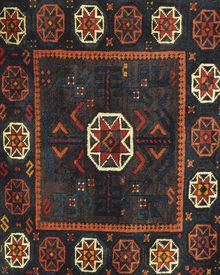Afghan Carpet
| Afghan Carpet | |
|---|---|
 | |
| General information | |
| Name | Afghan Carpet |
| Original name | فرش افغانستان، قالی افغانستان |
| Alternative name(s) | Afghan Rug |
| Origin | |
| Technical information | |
| Common designs | Turkoman, Geometric |
| Common colors | Red |
Afghan Carpet or Afghan Rug is one of the eastern rugs that woven in Afghanistan.
A country of Central Asia bordered by Iran, Turkmenistan, Uzbekistan, Tajikistan, China, and Pakistan. About 75 percent of the population is Sunni Muslim. Rugs are woven by native Afghans (Pashtun) and by Turkmen tribes, most of whom migrated to Afghanistan in the 1920s. These tribes include Ersari, Tekke, Yomud, and Sariq. There is some rug production from Baluchi and Uzbek peoples in Afghanistan. Pile rug production consists largely of pieces with traditional Turkmen guls and geometric designs in shades of red. A wide variety of flatweaves is produced along with bags, animal trappings, and other special-function tribal weavings.
Rug export from Afghanistan increased in the 1970s with the large-scale production of lower-quality rugs. Afghanistan carpets that are single-wefted and without offset warps may be termed yaktâr and those that are double-wefted with offset warps may be termed dotâr. Soviet Russian troops occupied Afghanistan in December of 1979 in support of a communist régime. Armed resistance to the occupying forces and to the civil government involved much of the rural population. Soviet troops withdrew in February of 1989 and the communist régime was defeated in May of 1992. Warfare resumed in 2002 with the United States incursion into Afghanistan. Rug production, marketing, and distribution were disrupted by warfare. Most descriptions of rug production and marketing centers refer to conditions in prewar Afghanistan.[1]
History
Afghanistan is a country located in south central Asia. The main Afghan languages spoken are Farsi (local dialect Dari), Pashtun, and Turkic. The population in Afghanistan is tribal, living in towns and villages, although many continue to live as nomads and seminomads throughout the country, and mainly work in agriculture, raising livestock and herding sheep.
The tribes who make rugs in Afghanistan are the Kyrgyz, Turkmens, and Uzbeks, in the northern region. The Hazaras, of Mongol origin, speak Dari and make flatweave rugs. The earliest rugs known from these tribes are made by the Turkmen Ersari, also called "Beshir", and date from the second half of the eighteenth century. In northern Afghanistan, the tribes weave large Turkmen Gul (flower) motifs in an octagonal shape called a "Filpa", which means "elephant footprint" in Farsi.
Another rug type from Afghanistan is the Baluch tribal rug. These are made for personal use and for domestic sales and foreign export. The rugs are made mostly in the western and central regions of Afghanistan by Baluch tribes. The Baluch are descendants of the Chahar Aimaq Baluch, whose name translates as "four tribes." During the seventeenth century, the Chahar Aimaq was formed by the Persian Safavid king Shah Abbas the Great (r. 1588-1629) to create a confederation of the four Baluch tribes in the Herat region. Over the centuries these four tribes created many subtribes who continue to weave Baluch rugs throughout Afghanistan and the Khorasan and Sistan and Baluchestan Provinces of eastern Iran. Some Afghan tribes weave Baluch rugs but are not of Baluch ethnicity, such as the Mushwani and Pashtun. All Baluch-style rugs woven by Baluch and other tribes in Afghanistan are categorized as Herat Baluch in the world market. Today some Afghan weavers who have settled in villages make various designs and qualities of rugs in accordance with market demand.
A discussion of Afghanistan's weaving history would not be complete without mentioning the ancient city of Herat. It is located in the northwestern region of Afghanistan near the border of Iran. Herat was known for art and culture, and was a part of Persia's Greater Khorasan Province. During the Golden Age of Safavid art, in the sixteenth and seventeenth centuries, Herat workshops were known to weave classical carpets. In this period a famous motif called Herati (fish) was widely used in weavings in Persia (Iran) and later in other countries, and it is still made today.[2]
References
Bibliography
- Abraham Levi Moheban. 2015. The Encyclopedia of Antique Carpets: Twenty-Five Centuries of Weaving. NewYork: Princeton Architectural Press.
- Peter F. Stone. 2013. Oriental Rugs: An Illustrated Lexicon of Motifs, Materials, and Origins. North Clarendon: Tuttle.